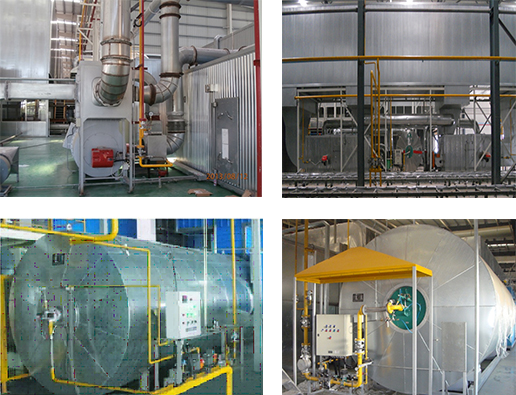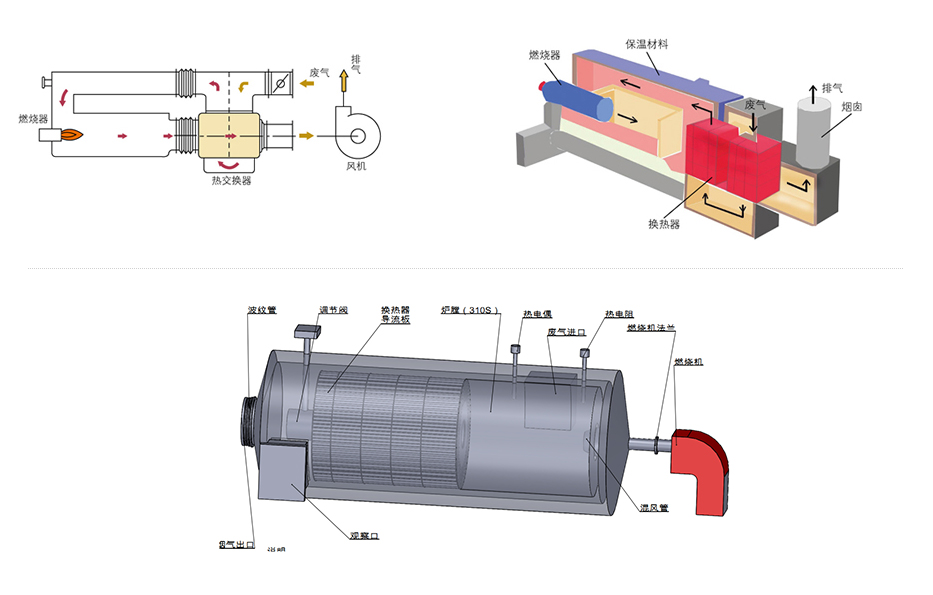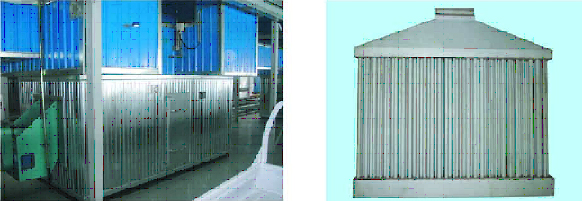
LINK:


Lvzhiyuan

 Lvzhiyuan
Lvzhiyuan

Heat recovery type waste gas incinerator system (LZS), referred to as TNV system.
Use natural gas (or light fuel oil) to directly burn and heat organic solvent-containing waste gas. Under the action of high temperature, the organic solvent molecules are oxidized and decomposed into CO2 and heat. The high-temperature flue gas passes through the supporting heat exchange device to heat the air or hot water required for the production process. Fully recycle the heat energy generated during the oxidation and decomposition of organic waste gas, and reduce the energy consumption of the entire system. Therefore, TNV is an efficient and ideal treatment method for treating high-concentration organic waste gas and waste liquid when a large amount of heat is required in the production process. According to the working principle of TNV technology, the heat after incineration of exhaust gas is concentrated and replaced for heat exchange and heating system, which is used for drying the surface of automobile painted body.
The TNV system consists of three parts: exhaust gas preheating and direct incineration system - exhaust gas incineration central heating device, exhaust gas extraction fan and exhaust gas pipeline; circulating air heating system - flue gas heat exchange device, flue gas pipeline and flue gas pipeline The electric regulating valve on the gas pipeline; the fresh air heat exchange system - the fresh air heat exchange device, the supplementary fresh air fan, the supplementary fresh air pipeline and the flue gas discharge pipeline.
The organic waste gas from the paint drying channel is sent to the incinerator preheater through the induced draft fan for heat exchange, and the temperature rises to above 350 °C, and then enters the furnace flame zone through a special mixing channel for further heating. Decomposed, the flue gas is led to the heat exchanger by the exhaust fan for heat exchange, and then passes through the (first, second, and third) flue gas circulation heat exchange device and fresh air heat exchanger for heat exchange, and heat preservation to the drying tunnel The area and both ends of the air curtain supply heat, and the flue gas after heat exchange is purified and finally emptied.

THREE:Characteristics of heat recovery type waste gas incinerator system
Environmental protection standard + full utilization of thermal energy
1. The oxidative decomposition and purification efficiency of organic waste gas is more than 99%; it meets the requirements of environmental protection and high purification rate emission standards;
2. The use of multi-stage heat recovery is used for hot air circulation in the drying tunnel, and the heat recovery efficiency is 90%;
3. The heat of the high-temperature incineration flue gas is fully utilized, the temperature of the exhaust gas at the end is low, and the energy saving effect is remarkable.
FOUR:Direct-fired waste gas incinerator
1. The direct-fired incinerator uses the heat generated by the combustion of the auxiliary fuel natural gas (or diesel) to raise the temperature of the combustible harmful organic volatile gas to the reaction temperature, thereby causing oxidative decomposition and releasing a large amount of heat; heating in the exhaust gas And during the oxidation process, the flue gas temperature rises rapidly to 730-850 °C; considering energy saving and consumption reduction; direct-fired exhaust gas incinerator + flue gas circulating heating system has been widely used in the coating industry. It can not only deal with the organic solvent waste gas volatilized during the drying process, but also realize the recycling of thermal efficiency back to the drying tunnel.

2. Process description
The organic waste gas is discharged from the drying tunnel by the exhaust fan, sent to the internal heat exchanger of the direct-fired waste gas incinerator for preheating, and then enters the high-temperature combustion chamber, where it is stirred and mixed with the flame zone of the burner. The organic waste gas is oxidized and decomposed, and the decomposed organic waste gas becomes CO2 and heat. The generated high-temperature flue gas is discharged through the heat exchanger in the furnace and the main flue gas pipeline, and the discharged flue gas is used as the heat source of the drying tunnel for waste heat exchange and reuse.

3. Structural characteristics of direct-fired waste gas incinerator
The heat exchange and combustion heating of the direct-fired incinerator are designed as a whole, and a sliding structure is adopted between the base and the base;
The floating structure design of combustion tube, heat exchanger and inner tube can eliminate the expansion caused by internal stress;
There is an electric regulating valve in the exhaust duct to adjust the exhaust air volume and exhaust temperature of the main flue;
Install a temperature measuring thermal resistance element to detect the preheating temperature and combustion temperature of the exhaust gas, and the control element is interlocked with the burner;
The equipment is equipped with a pressure relief port and an observation hole; there is an inspection port on one side of the smoke exhaust area, which is convenient for entering the furnace for cleaning and maintenance;
For the mixed gas of organic solvent vapor, when its concentration is close to 1/4 of the explosion limit value, in order to reduce the risk of explosion, the fresh air is used to increase the oxygen and then enter the incinerator for oxidative decomposition; the reaction (combustion) temperature of the exhaust gas is 730-850 °C;
When the organic waste gas concentration is less than 2000ppm, the auxiliary fuel (natural gas) is used to provide heat, so that the combustible substances in the waste gas reach the light-off temperature and decompose.
FIVE:Flue gas circulating heat exchange device
The device is mainly used for the waste heat recovery equipment of the direct-fired waste gas incinerator in the coating line. Since the exhaust gas temperature of the waste gas incinerator is too high, the device is evacuated after heat exchange with the circulating air of the drying room to save energy.
The flue gas circulating heat exchanger can adopt one-level, two-level and three-level methods.

1. Process flow
The devices are used in series to heat the circulating air in the paint drying tunnel by using high-temperature flue gas to provide the required heat for the paint drying tunnel. The high temperature circulating fan is adopted, and the electric three-ventilation valve is installed on the top flue gas pipeline. The flow rate of the flue gas entering the heat exchanger can be adjusted, and the control is flexible, the operation is reliable, and the effect of temperature control is achieved.
2. Equipment features
The equipment is mainly composed of a high-temperature plug-in fan, a high-temperature high-efficiency air filter, a flue gas heat exchanger and a heat preservation chamber;
The device room adopts the structure of thermal insulation wall plate, the inner plate is galvanized steel plate or stainless steel plate; the outer plate is galvanized corrugated plate (or color steel pressure-shaped plate), the middle is the insulation layer, and there is an inspection door on one side of the device;
The fan adopts plug-in fan, which has compact structure and convenient maintenance;
High temperature filter, large filtering area, large dust holding capacity and small resistance; equipped with differential pressure gauge to display the dust holding capacity of the filter;
The structure is beautiful in appearance, the environmental noise is small, and the maintenance is convenient.
SIX:Specifications of direct-fired waste gas incinerator
Model | Handling air volume | Natural gas | Heat supply | Remark |
LZS-150 | 1500 | 30 | 106×104 | Upper and lower structure |
LZS-200 | 2000 | 38 | 137×104 | |
LZS-300 | 3000 | 60 | 163×104 | Left and right structure |
LZS-350 | 3500 | 70 | 232×104 | |
LZS-400 | 4000 | 80 | 266×104 | |
LZS-500 | 5000 | 100 | 334×104 | |
LZS-600 | 6000 | 120 | 400×104 | |
LZS-800 | 8000 | 158 | 525×104 | Internal and external structure |
LZS-1000 | 10000 | 200 | 662×104 | |
LZS-1200 | 12000 | 240 | 799×104 |